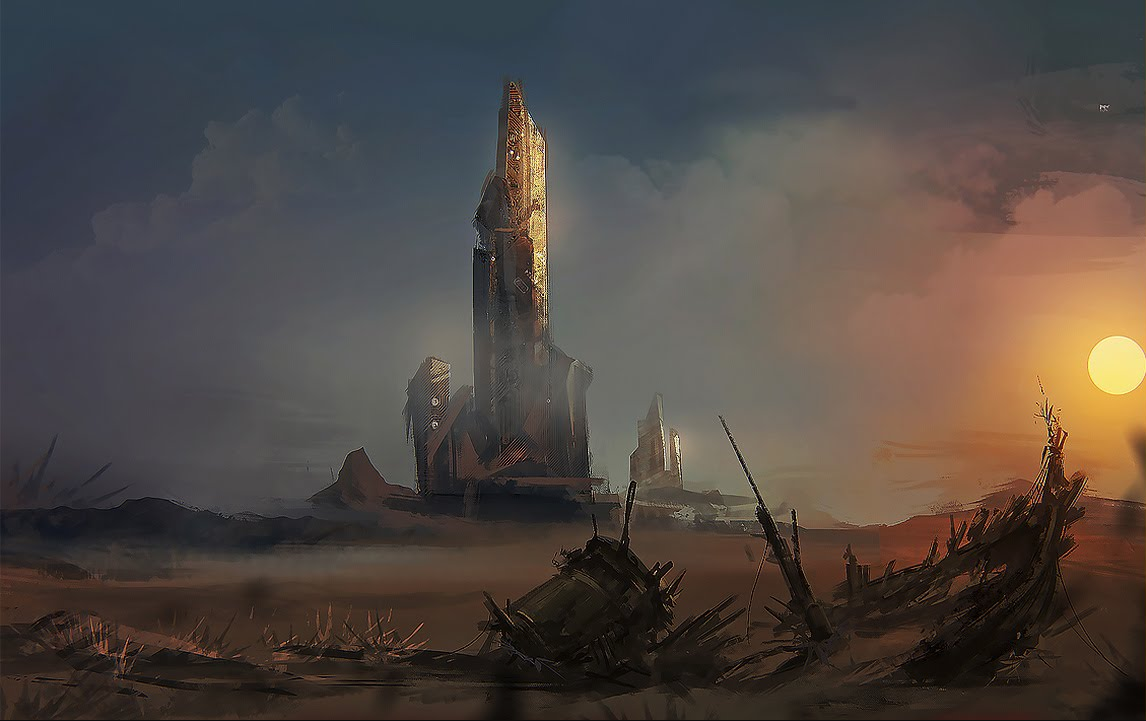Tor
"For the longest time, we knew nothing more than the sands we walked on and the water we swam in. We had no concept of the greater universe. Though we've now left home, we still remember who we are descended from: Mother Tor."
-Toreni Mystic
Geography
Most of the planet is covered by saltwater oceans, and the small amount of land above water is covered by desert save for a few small islands near the poles. Tor is only a bit more massive than Earth with around 1.12 times the gravity. From space, the planet is mostly blue with highlights of a very light rust-like color marking the land. Towards the pole, small green islands can be seen.
The oceans of Tor are notorious for their choppy waters and shipwrecking storms, though coastal waters tend to be a lot calmer. Most of the major oceans are freckled with small volcanic islands akin to the Galapagos which harbor greenery and life, though are nowhere near with size of the polar islands which can rival the size of Greenland.
The deserts of Tor are notoriously inhospitable to most types of life, though some types still find a way. Vicious dust storms whip across the dunes, changing the topography of the deserts almost daily. Farther inland, the deserts give way to steppes and mountains. Dry, hardy vegetation can grow here.
The poles are noticeably colder than the rest of the planet. Whereas the temperature range closer to the equator sits anywhere from 90F-120F (32C-49C), the poles are much more comfortable at 50F-70F (10C-20C). Rarely, snowfall can occur at night during the winter months in these regions, though it never accumulates more than an inch. The landscape here is very similar to the Northern Fjords of Scandinavia, the Taigas of Canada, and the Moorlands of Scotland.
Fauna & Flora
The flora and fauna found on Tor are just as diverse as anywhere else, though several notable differences can be made. Life that has evolved on Tor tend to share a few common characteristics. Most flora and fauna are bio-luminescent. Though the usage of this varies, most organisms can produce a rainbow of colors via various parts of their body. Additionally, fauna tend to have more than two eyes. Sometimes the additional eyes are fully developed, complex eyes. Other times, they are simple eyes that can only detect the presence and absence of light. Armor is frequently used by both plants and animals, though the type of armor varies from species to species. Some may have armored carapaces, others may have flexible scales. Finally, hemerythrin is the most common oxygen-carrying protein in use by fauna of Tor.
The oceans of Tor are filled with a vastly diverse range of animals fitting both broad and specific niches. While most animals fit into the fish category, there are some insects and some un-classifiable organisms found in the depths of the ocean. Most organisms here use bio-luminescence in a variety of ways. On the surface, large jellyfish-like Gasbag can be seen drifting along the wind currents, fishing for food with their long tentacles.
The deserts of Tor, while containing a lot less life, still have their own unique set of flora and fauna. Cactus-like plants can grow in the shifting sands, as well as a few species of unique, mobile plants. The fauna here are mostly armored insects and reptilians that are cold-blooded. The famous Gol'tu Burrowers make their homes underneath the sands. Bio-luminescence is less common here, but can still be found in a few species.
The steppes of Tor host a variety of aerial fauna and hardy, elk-like mammals. Bio-luminescence resurfaces again here due to the fast amount of cave systems carved by ancient, dried-up rivers. In the mountains, the Monda Nest-Raider is a common sight. With arms twice the size of its torso, it scales up and down mountains looking for nests of birds as it feeds almost exclusively on eggs.
The islands of Tor tend to host smaller, tame animals. There are virtually no animal predators in these regions as edible flora tends to be extremely bountiful. However, animals here are still preyed on. Not by other animals, but by the plants themselves. The Exploder Tree does exactly what its name implies: explode. Though the tree itself doesn't explode, only its fruit. When special trigger hairs at the base of the tree detect movement, fruit will break away from the branches of the tree and fall to the ground where it will rupture. Liquid from the fruit will then react with an enzyme released by the trigger hairs and it will violently explode with the force of your average hand-grenade, killing whatever triggered the plant. The viscera from its victim will then soak into the tree's root system which it then uses to fuel various biological processes.
Natural Resources
As with any planet, the resources on Tor tend to be varied. However there are a few differences to be made from Earth. Unlike Earth, food on Tor tends to be scarce. This scarcity is what makes life on Tor so niche and varied. On the upside, Tor is a very metallic planet. The sand of the desert isn't made from silica, rather, it's made from iron. This is why the sands of Tor have an orange-red tinge. The sand itself can be smelted into iron without the need to dig for ore. Oxygen is also almost triply plentiful as it is on Earth. Humans tend to complain that their "lungs are burning" when breathing air on Tor.
Remove these ads. Join the Worldbuilders Guild









Comments